The Worcester Insane Asylum, also known during its lifetime as Worcester State Hospital and the Bloomingdale Asylum, underwent several phases of construction. The original hospital, built in 1832 to house 120 inmates, was expanded to accommodate 360 people by the mid-1840s.
A brand new, much larger, Kirkbride plan complex was finally erected 1873-1876, although a number of patients deemed “incurable” remained incarcerated in the older building, which was renamed as the Asylum for the Chronic Insane.
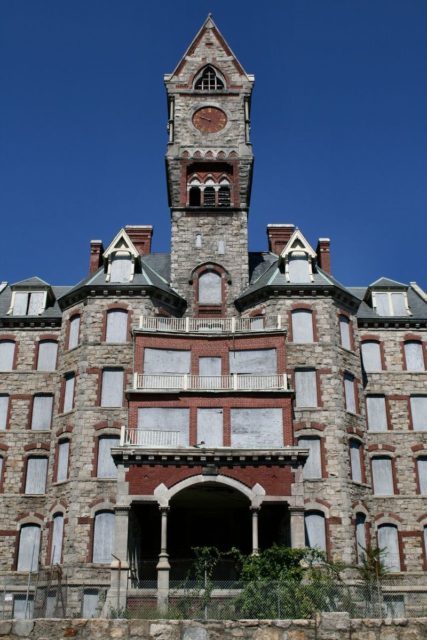
Demolition of the hospital also took place in phases. A fire in 1991 left most of the buildings beyond repair, and by 2008 only the Clocktower and the Hooper Turret remained. Both were also scheduled to be reduced to rubble, but thanks to a decade-long campaign by locals and historical organizations, the clock tower has been preserved as a historical monument.
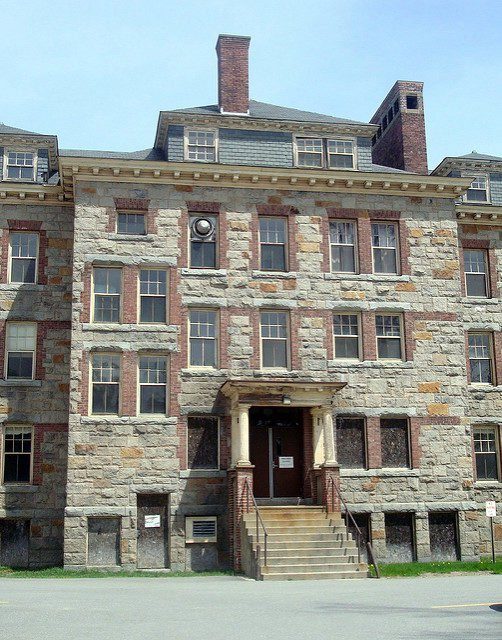
On February 23, 1829, a committee was appointed by the House of Representatives “to examine and ascertain the practicability and expediency of erecting or procuring, at the expense of the commonwealth, an asylum for the safekeeping of lunatics and persons furiously mad” in the state of Massachusetts.
At that time, those who had the financial means could send their “afflicted” kin to one of the few private asylums dotted around the U.S. The mentally ill and severely disabled whose families either couldn’t afford or simply couldn’t cope with caring for their needs at home, might find themselves in an almshouse, or even locked away in jail.
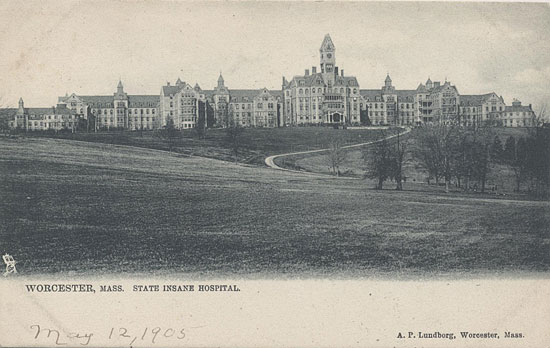
Governmental representatives of several counties were required to estimate the numbers of “insane persons” in the community. Based on their returns, an asylum designed to accommodate 120 inmates was erected. It was formally opened as the State Lunatic Hospital at Worcester on January 12, 1833, and Massachusetts became the sixth state to provide provide publicly funded care for the mentally ill. The first superintendent was Samuel B. Woodward, M. D.
Perhaps unsurprisingly, the estimates turned out to be woefully inadequate — during the first year alone, 164 patients were received.
Expansion of the hospital buildings began around 1835 and bed-space was increased threefold during the institution’s first decade of operation.
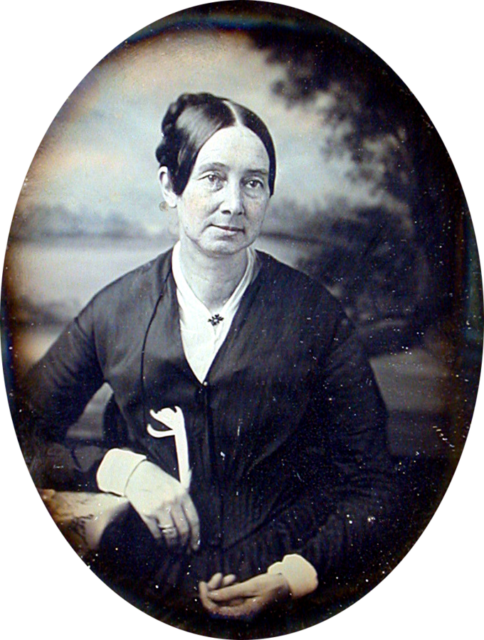
But the Massachusetts State Insane Hospital was still constantly over capacity and had to turn away many needy patients. The dedication of campaigners such as Dorothea Dix led to a reform of the Commonwealth’s mental healthcare provision. The overcrowding issue was first addressed by building new asylums, at Boston, Taunton, and Northampton. Plans to rejuvenate the facility at Worcester were not made until 1869.
A plot was purchased on Belmont Street and it was decided the new campus should adhere to the fashionable “ideal” layout according to Moral Treatment pioneer Thomas Kirkbride. The Kirkbridge building was designed by architect George Dutton Rand of Weston & Rand. Its centerpiece was the 135-feet-high “Clocktower” administration building.
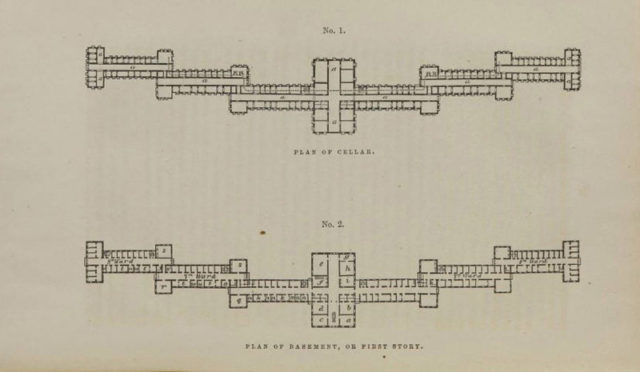
The first patients were admitted on October 8, 1877. The hospital buildings and grounds were improved and redeveloped under successive superintendents. Dr. John G. Park encouraged physical activities for patients, and secured the purchase of 130 acres of grazing land at Hillside Farm in Shrewsbury.
Dr. Hosea M. Quinby oversaw the addition of an infirmary, bathhouse, and two nurses homes. A training school for assistant physicians was also initiated on his watch, as was a research laboratory — although we imagine that many of the methods being investigated back then would be abhorrent to us today.
Disaster struck the Worcester State Hospital in 1991, when a fire tore through huge sections of the Victorian buildings, leaving them severely damaged.
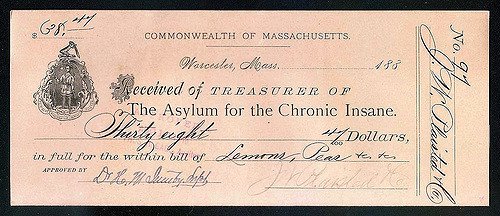
Facilities were limited, but the hospital was still able to operate on the campus in the buildings unaffected by the fire, until 2004. According to Asylum Projects, “The burned sections were bulldozed and the extra stone was used to seal up the gaping holes left by the connections to the still remaining sections.”
In 2008, the director of the movie Shutter Island wanted to shoot scenes inside this hospital but filming was not approved because of the pending demolition of the facility, and instead the filming took place at Medfield State Hospital.
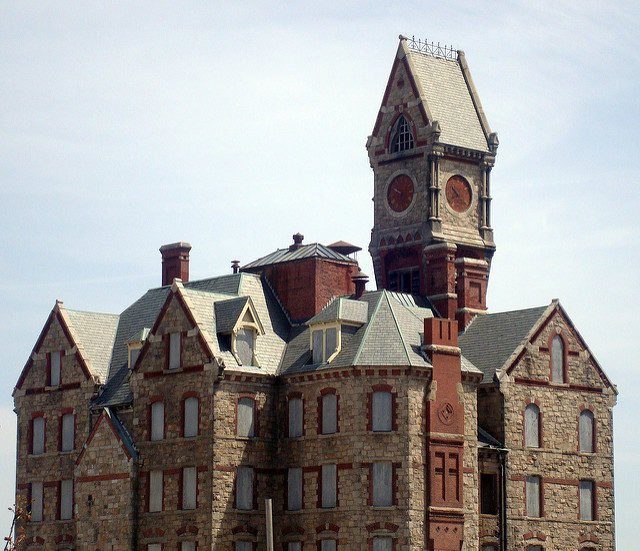
Later that same year, most of the remaining buildings were torn down. Construction of a modern mental health facility on the grounds of the old institution began in May 2009.
The Massachusetts Department of Mental Health 320-bed Worcester Recovery Center and Hospital was opened October 2012.
As reported by The Telegram, “Historic preservation advocates and others in the community tried to get the state to repair the administrative building and clock tower.”
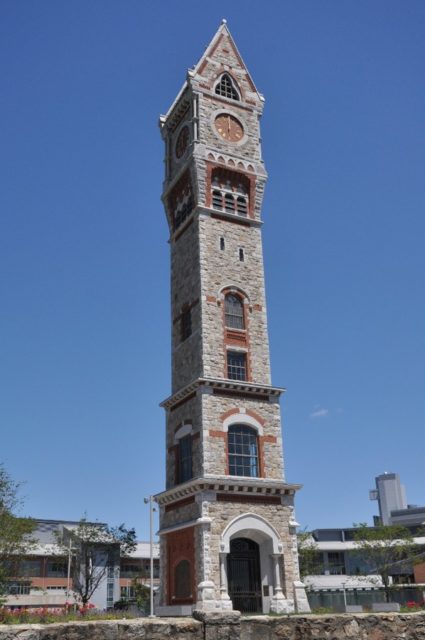
A ‘Save the Clock Tower’ campaign group was formed and they were able to successfully raise enough awareness, and funds, to secure the future of a local landmark. The clock tower itself was carefully taken down, a delicate process due to the unstable structure and risk of asbestos contamination. Preservationists were able to salvage and restore the original upper portion, and a new tower base was carefully crafted in the same Gothic style.
The reconstructed clock tower dedicated as the Clocktower Monument in December 2015.
“The clock tower monument stands as a beacon of recognition over the staff and the patients this facility has helped over the years,” said Lt. Gov. Karyn Polito.
